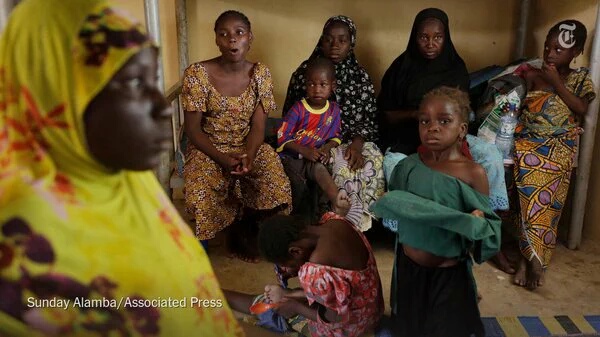WORLD
Nigerian Women Freed From Boko Haram Face Rejection at Home

A new crisis is emerging as the Nigerian military liberates droves of women and girls from their Boko Haram captors: Many of the newly freed are being rejected when they return to their communities, according to a report released Tuesday.
The women and girls, many of whom were raped by militants, have been labeled “annoba,” which means epidemics, or “Boko Haram wives,” according to thereport from International Alert, a peace-building group, and Unicef. Some community members worry that they have been radicalized by Boko Haram and might try to recruit others to fight with the militant group, which has been terrorizing northern Nigeria for years.
“There is a fear that if the needs of these survivors and returning populations are not met, these factors could add another dimension to an already complex conflict situation in northeast Nigeria,” said Kimairis Toogood, an adviser for International Alert in Nigeria.
As many as 2,000 women and children, both girls and boys, have been abducted by Boko Haram since 2012, according to the report. That includes the more than200 girls taken from their secondary school in Chibok in 2014 in an episode that attracted huge social media attention with a #BringBackOurGirls campaign, which ultimately had little impact. The Nigerian government conceded recently that it still does not know the girls’ whereabouts.
Some of the women who have been released are pregnant or have given birth to children whose fathers are Boko Haram fighters. Community members told researchers that the children had “bad blood” transmitted from their fathers. Even some of the released women were uncertain about their own children.
According to the report, one pregnant woman said, “When I think of the baby that will come, it disturbs me a lot because I always ask myself this question: Will the child also behave like JAS?” JAS is another name for Boko Haram.
In one area, a community leader described the children of Boko Haram fighters as “hyenas among dogs,” the report said.
The rejections are among numerous unintended consequences of the military’s generally successful push to liberate miles of territory that Boko Haram had held for months.
As soldiers have scattered Boko Haram, fighters have sent suicide bombers throughout northeastern Nigeria and across borders to other countries. In some areas, the attacks have become almost-daily occurrences.
The United Nations estimates that the violence has prompted 2.8 million people to flee their homes. Many are living in camps or in crowded homes with relatives. Some face food shortages, a looming crisis made worse by low oil prices that are pinching the nation’s budget.
Aid workers fear that the situation could explode into famine in areas like Borno State, a frequent target of Boko Haram, where 50,000 people have been deemed “critically food insecure,” according to the United Nations. The United Nations estimates that 223,000 severely malnourished children in northern Nigeria and neighboring countries could die if not helped immediately.
The skepticism over newly released female captives of Boko Haram may be fueled by the increasing number of female suicide bombers who are carrying out attacks in northern Nigeria.
Aid workers believe that some female captives have been trained to fight or encouraged to become suicide bombers. Some combat experts believe that the female suicide bombers are brainwashed; others believe that they are unaware and that the devices are remotely detonated.
Interviews last week with a girl estimated to be in her late teens, who decided not to detonate her device at a camp for displaced people near Maiduguri, indicated that she and two fellow bombers were aware of the consequences of their actions, local government officials said. The girl threw her explosives in the bush after she recognized her parents among the camp inhabitants she had intended to blow up. The other girls exploded their devices, killing and injuring dozens.
Each of the three girls wore their hair pulled away from their faces in a traditional burial style for women, according to the local authorities, signaling that they were prepared to die.
The New York Times

NEWS
Tinubu Congratulates Tunde Onakoya On New World Chess Record
By Ebriku John Friday
President Bola Tinubu congratulates Mr. Tunde Onakoya on setting a new world chess record and sounding the gong of Nigeria’s resilience, self-belief, and ingenuity at the square of global acclaim

World Chess King Tunde Onakoya
.
Mr. Onakoya broke the Guinness World Record for the longest chess marathon on Saturday, after playing for over 58 hours and winning every match in tow.
Chief Ajuri Ngelale Special Adviser to the President (Media & Publicity) disclosed this on Saturday in a statement made available to journalists in Abuja.
President Tinubu celebrates the Nigerian Chess Champion and founder of Chess in Slums Africa for the rare feat, but especially for the reason driving this compelling demonstration of character, which is raising funds for African children to learn and find opportunity through chess.
The President states Mr. Onakoya has shown a streak customary among Nigeria’s youth population, the audacity to make good change happen; to baffle impossibility, and propel innovations and solutions to the nation’s challenges, even from corners of disadvantage.
The President affirms that Nigeria’s youths have demonstrated in all fields, including Afrobeats, Nollywood, the pulsating skit-making enterprise, education, science, and technology, that great exploits can truly come from small quarters.
President Tinubu commends the inclination of Nigerians – across artificial partitions – for unity, once again exemplified through their undiluted support for this epoch-making endeavour.
The President assures all citizens that his administration remains strongly committed to creating and expanding opportunities for the youth to explore and exercise their abilities and become the symbols of greatness our nation represents into the future.
WORLD
World Bank: UNAIDS Calls For Sustained And Expanded health and HIV investments
|
NEWS
Guinness World Record: Nigerians Cheer Onakoya As 58-Hour Chess Marathon Begins In New York

Nigerians abroad have come out to support renowned chess master, Tunde Onakoya, as he embarks on a mission to surpass the Guinness World Record for the longest chess marathon.
Onakoya announced the commencement of the marathon via his X account with the caption, “Game time.”
He also wrote, “We haven’t even started yet and Nigerians are already trooping in to camp out with me.”
Among those cheering Onakoya is Nigerian singer, Adekunle Kosoko, popularly known as Adekunle Gold.
The event, which is underway at New York City’s iconic Times Square, started at 10am on Wednesday, April 17, and is scheduled to end at 8pm on April 19.
Onakoya is set to engage in an intense chess marathon, aiming to play for 58 hours without a single defeat.
The current Guinness World Record, set by Hallvard Haug Flatebø and Sjur Ferkingstad of Norway on November 11, 2018, stands at 56 hours, 9 minutes, and 37 seconds.

Credit: X | Tunde_OD
—
Follow us for more breaking news and videos




